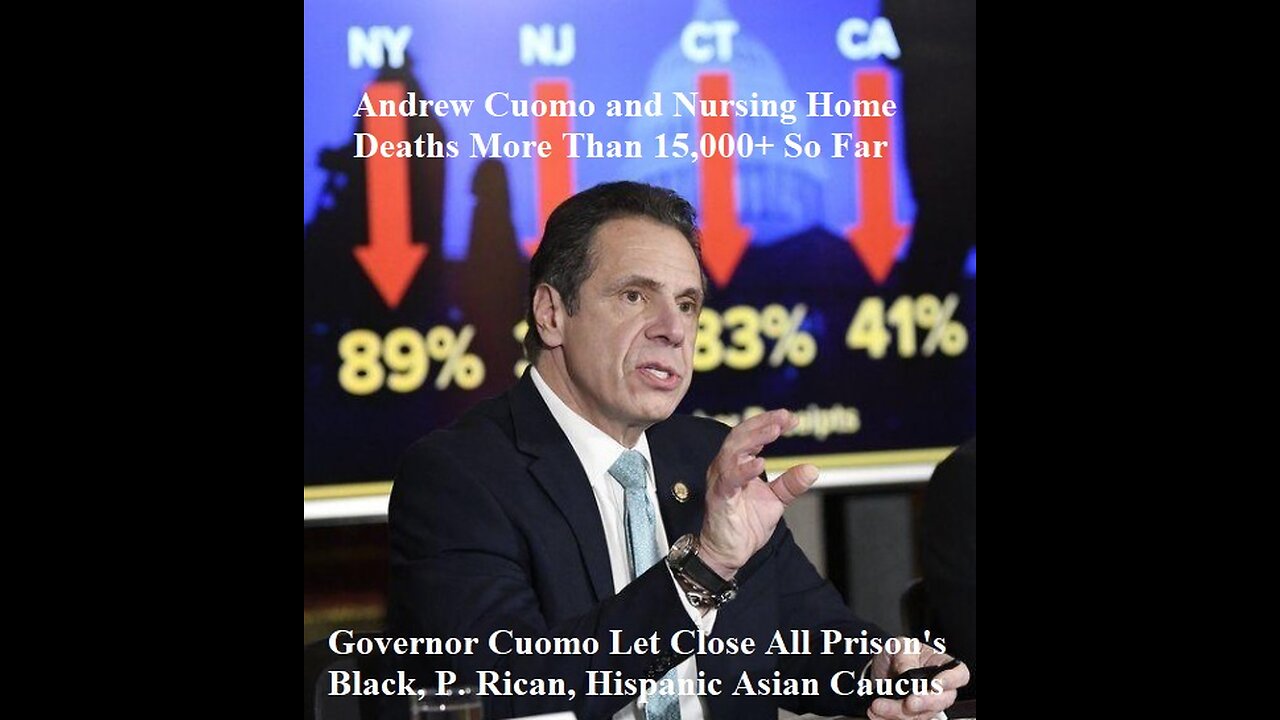Premium Only Content

Governor Cuomo Let Close All Prison's Black, Puerto Rican, Hispanic, Asian Caucus
Governor Cuomo Attends Black, Puerto Rican, Hispanic and Asian Legislative Caucus’ 44th Annual Scholarship Gala Reception NY Governor Cuomo Announces the Closure of Seven State Prisons. New York Governor Andrew Cuomo has announced the closing of seven state prisons, saying the action reflects a declining prison population and will save money. Capitol Correspondent Karen DeWitt reports...
Governor Cuomo announced several months ago that he would shrink the state's prison capacity by 3800 beds. Now, he says he'll close four minimum security prisons, including work release facilities, in Buffalo, the Bronx and Central New York, and a shock incarceration prison in Schoharie County. Three medium security prisons in the Hudson Valley and Utica area will also close.
The governor says the closures will save $184 million dollars and eliminate "unneeded and unused beds," due to a declining prison population and crime rate over the past decade. He also attributes the drop to reforms to the state's harsh Rockefeller Drug Laws.
A spokesman for the state's prison guards union says the closures represent a "significant threat to the safety and integrity" of the prison system.
The state budget office is offering $50 million dollars in economic development grants to the communities impacted by the loss in correction officer and other prison related jobs.
New York's governor is recommending a proposal that would give him the ability to close state prisons on a faster timeline.
The measure is included in Gov. Andrew Cuomo's budget proposal, which was rolled out Tuesday. The proposal would allow the governor to close state prisons if he gives at least a 90-day notice to legislative leaders. Additionally, Cuomo is looking to close several prisons.
The significant decline in crime coincides with a 38 percent drop in the State’s prison population from a peak of 72,600 in 1999 to a current population of approximately 44,500 – the lowest level in more than two decades. Through this decline, excess capacity has begun to build and as a result the Governor has recommended the closure of several facilities to effectively right-size the prison system.
The corrections officers union said the move puts them at risk.
"It'll immediately make prisons less safe," said NYSCOBA Western Region Business Agent Kenny Gold.
He said if a prison closes, inmates will be moved elsewhere, which may lead to double-bunking. He said the practice puts both staff and inmates in danger because there's more inmates for staff to monitor, and the inmates are living within a few feet from each other.
The state prison population is at the lowest level in more than two decades, according to New York State; however, Gold said corrections officers feel the pressure more than ever and closing prisons won't help. According to the State Department of Corrections and Community Supervision, the number of assaults on both staff and inmates is about 40% higher than five years ago.
Gold said the new proposal giving staff 90 days notice that their prison is closing, instead of a year, is blindsiding.
"It changes their whole livelihood, it uproots them and puts them in a different prison they don't know," Gold said.
He said it also has a ripple effect on the economy of a community. Livingston Correctional Facility closed in September, it had over 300 employees in a town of approximately 3,200 people.
There's no word yet on what prisons Cuomo is looking to close, or how many. If approved, the measure would be effective from April 2020 through March 2021.
NEW YORK’S NURSING HOME NIGHTMARE
Through the first 11 months of New York’s coronavirus pandemic, the true toll in New York nursing homes remained hidden.
The Health Department’s public reports counted only residents who died physically within the homes, leaving out potentially thousands more who died after being transferred to hospitals. This understated the human loss and impeded efforts to learn critical lessons from a public health catastrophe.
To obtain the full truth, the Empire Center filed suit against the Health Department under the Freedom of Information Law. On Feb. 3, a court ruled in favor of the center’s case and ordered the Health Department to produce the requested records. On Feb. 10, after delaying for more than six months, the department provided the dates and locations of nearly 16,000 deaths involving long-term care residents, including more than 5,000 that occurred in hospitals.
Latest Updates on Empire Center v. Department of Health
Monday, May 17: Tax documents reveal Governor Cuomo’s COVID-19 book deal was worth over $5 million.
Tuesday, April 20: More than 5,000 New Yorkers sign on to an Empire Center petition calling on the New York state government to release the full nursing home data.
Tuesday, April 6: Governor Cuomo repeals the legal immunity granted to New York nursing homes during the pandemic, meaning they can be held liable for the treatment of patients with coronavirus.
Wednesday, March 31: The New York Times reports that, while government staff was working on Governor Cuomo’s COVID-19 memoir, they were concurrently omitting actual nursing home death toll numbers from health department reports.
Friday, March 5: The Wall Street Journal and The New York Times report that aides to Governor Cuomo altered a July report on nursing homes from the Health Department to remove a more comprehensive count of deaths, omitting thousands of residents who had died in hospitals.
Thursday, March 4: An Empire Center analysis of nursing home data finds little or no evidence that staffing levels or for-profit ownership correlated with resident mortality. It also reports that the seven state-owned facilities, five of which are dedicated to veterans, collectively had the highest death rate of any ownership sub-group.
Thursday, Feb. 18: An Empire Center analysis of newly released state data finds a statistically significant correlation between COVID-positive admissions to nursing homes and higher death rates in those facilities.
Friday, Feb. 12: The Albany Times Union reports that the FBI and the U.S. attorney’s office in Brooklyn have opened an investigation of the Cuomo administration’s handling of the pandemic in nursing homes.
Thursday, Feb. 11: The New York Post reports that a top aide to Governor Cuomo privately told legislators that the administration had withheld nursing home data because they were concerned it would be used against them by President Trump and federal investigators.
Wednesday, Feb. 10: The Health Department responds to the Empire Center’s FOIL request with the dates and locations of more than 14,000 deaths involving residents of nursing homes and assisted living facilities, including 4,775 residents who died outside of the facilities from confirmed cases of COVID-19. Omitted from the data were: 671 residents who died outside the facilities with presumed cases of COVID-19, and approximately 1,000 deaths in adult-care facilities that are not categorized as “assisted living.”
Saturday, Feb. 6: In a first step toward complying with the Feb. 3 court order, the Health Department posts updated facility-level death counts in nursing homes as well as assisted living facilities and other adult-care facilities, including 5,596 deaths that occurred in hospitals. The update pushes the known COVID-19 toll in long-term care facilities to almost 15,000, 63 percent higher than it was 10 days earlier.
Wednesday, Feb. 3: Judge Kimberly O’Connor rules that the Health Department is in violation of the Freedom of Information Law, orders release of the requested nursing home data within five business days and awards attorney’s fees and court costs to the Empire Center.
Friday, Jan. 29: In a letter to Judge Kimberly O’Connor, the Empire Center’s attorney highlights findings of the attorney general’s report and urges the court to issue a ruling.
Thursday, Jan. 28: A report by Attorney General Letitia James confirms that the Health Department has been undercounting nursing homes deaths and estimates that the full toll is 50 percent higher than what the department has reported. In a response, Health Commissioner Howard Zucker reveals for the first time that nearly 4,000 nursing home residents had died of COVID-19 in hospitals as of Jan. 19, bringing the total nursing-home toll to almost 13,000.
Tuesday, Jan. 19: In a letter to Judge Kimberly O’Connor, the Empire Center’s attorney notifies the court about the Health Department’s latest extension letter, which postpones release of the requested nursing home mortality data until March 22 or later.
Wednesday, Jan. 13: In a third extension letter, the Department of Health further postponed releasing the full count of nursing home deaths until at least March 22, more than seven months after the Empire Center’s original Freedom of Information Law request. Repeating its previous explanation verbatim, DOH said it needs time to review the records for “applicable exemptions, legal privileges and responsiveness.” It again warned that additional delays are possible.
Monday, Nov. 9: In a letter to Judge Kimberly O’Connor, the Empire Center notifies the court about the Health Department’s latest extension letter, which postpones release of the requested nursing home mortality data until Jan. 13 or later.
Thursday, Nov. 5: In a second extension letter, the Department of Health further postponed releasing complete nursing-home death counts until at least Jan. 13, more than five months after the Empire Center’s Freedom of Information Law request. DOH said it needs time to review the records for “applicable exemptions, legal privileges and responsiveness,” and warned that additional delays are possible.
Friday, Oct. 30: Empire Center v. New York State Department of Health is assigned to Hon. Kimberly O’Connor, acting state Supreme Court justice in Albany County.
Thursday, Oct. 29: The Empire Center files its reply affirmation, rebutting the arguments in the state’s response.
Monday, Oct. 26: In its response to the Empire Center’s lawsuit (linked below under “Key Documents”), the Health Department contends that delaying release of its nursing home mortality data by at least three months, and possibly more, is permissible under the state’s Freedom of Information Law.
Thursday, Oct. 22: The state’s formal response to the lawsuit was delayed three business days after an attorney for the Health Department requested a filing extension. The response had been due on Oct. 22, and the Empire Center agreed to a new deadline of Monday, Oct. 26. The state separately asked to postpone the Oct. 30 return date, which is when a Supreme Court judge in Albany County is due to formally take up the case. The Empire Center opposed that request.
Monday, Oct. 12: The state health commissioner, Dr. Howard Zucker, says his department will release data detailing COVID deaths in nursing homes and assisted living facilities “once we have checked there’s no duplication.”
Tuesday, Sept. 29: Sen. James Tedisco, R-Saratoga, announces that he is filing a friend-of-the-court brief in support of the Empire Center’s case.
Friday, Sept. 25: The Office of the Attorney General, which is representing DOH, assigns an attorney to the case and requests a routine two-week adjournment. Briefs from both sides are due before a court date of Oct. 30.
Friday, Sept. 18: The Empire Center for Public Policy files suit against the Department of Health in state Supreme Court, seeking to enforce its Freedom of Information Law request for the complete count of coronavirus deaths in nursing homes.
Wednesday, Sept. 16: DOH rejects the Empire Center’s appeal.
Tuesday, Sept. 1: The Empire Center files an appeal to DOH, arguing that the requested data is readily available in the department’s Health Emergency Response Data System, or HERDS.
Monday, Aug. 31: In a letter to the Empire Center, DOH says it will respond to the Empire Center’s FOIL request no sooner than Nov. 5 “because a diligent search for relevant documents is still being conducted.”
Monday, Aug. 3: The Empire Center files a Freedom of Information request with the Department of Health seeking “records of COVID-19-related deaths of residents of nursing homes and assisted living facilities, including those who died while physically outside of the homes.”
https://www.empirecenter.org/nursinghomes/
More than 172,000 residents and employees of nursing homes and long-term care facilities have died of complications from Covid-19 in the United States, according to a Times analysis. New York leads all states in such deaths, with more than 15,000 so far. By the time the Health Department issued its July report, Mr. Cuomo had been under fire over nursing homes for months.
https://en.wikipedia.org/wiki/New_York_COVID-19_nursing_home_scandal
The Congressional Black Caucus (CBC) was established in 1971 to put forth policy and legislation that ensured equal rights, opportunity, and access to Black Americans and other marginalized communities. It is a non-partisan body made up of African American members of Congress. The CBC was created during the high point of the Black Power Movement, when African Americans wanted greater political influence, and were gaining more seats in Congress.
When President Nixon refused to meet with the Caucus after its formation, the CBC boycotted the 1971 State of the Union. Stating that Nixon's refusal to meet with them demonstrated the administration's disregard of African American interests, the boycott resulted in a lot of media attention, and Richard Nixon met with members on March 25, 1971. At the meeting, the CBC presented Nixon with sixty-one recommendations to eradicate racism, provide quality housing, and promote engagement of African Americans in government. The records at the National Archives regarding the CBC include Legislative minutes, videos, and photographs of members meeting with US presidents, other members of Congress, and their constituents.
https://en.wikipedia.org/wiki/Congressional_Black_Caucus
Ben Carson: Congressional Black Caucus Is ‘Racist’ If the Congressional Black Caucus does indeed have a policy that prevents nonblacks from becoming voting members of the organization, it is acting in a racist fashion, according to Dr. Ben Carson.
The former neurosurgeon made his comments in an interview uploaded to YouTube, also adding, “If members of the Congressional Black Caucus would object if there were, let’s say, a Congressional Irish Caucus that wouldn’t let them in, then I think that would be hypocrisy and it would, in fact, be racist.
“During the civil rights movement, a lot of the people who worked feverishly were not black, and if they simply said, ‘You people can’t be involved,’ I wonder how much progress we would have made,” he continued.
The Congressional Black Caucus has always been a black organization since its founding in 1971 and has never had a white member before, according to FactCheck.org. That being said, the group's stated mission is more encompassing, striving to empower “neglected citizens” regardless of color.
The interviewer pushed Carson on his definitions of racism and what qualifies as racist.
“I would define it as people making decisions about others based on superficial characteristics and unfairly doing so,” Carson said. “And in our society today, I think a lot of racism is paternalism. I mean, you believe that certain people can’t do things and that you must do them for them.”
According to Carson, Martin Luther King Jr. would be “very unhappy” if he saw people being “judged based on … superficial characteristics.” As for policies like affirmative action? “What I have advocated is something that I call compassionate action, and what that means is that you look at the whole composite … not just race per se. I would be much more inclined to look at a person’s total circumstances,” the retired neurosurgeon said.
On December 8, 1976, Representatives Badillo, González, de la Garza, and Roybal and Puerto Rican Resident Commissioner-elect Baltasar Corrada-del Río announced the formation of the Congressional Hispanic Caucus (CHC). While several of the founding Members had served in Congress since the 1960s, they had not formed a group to focus on issues that were important to Hispanic Americans. Since 1971, Badillo had urged the creation of a Hispanic Caucus to foster greater unity among the Hispanic Members. The founders of the CHC stated that their mission was “to develop programs … to increase opportunities for Hispanics to participate in and contribute to the American political system” and to “reverse the national pattern of neglect, exclusion and indifference suffered for decades by Spanish-speaking citizens of the U.S.” “The fact that we have joined together is a sign of the growing power of our community, and we are looking forward to strengthening the Federal commitment to Hispanic citizens,” the caucus declared. Roybal was the CHC’s first chairman. For reasons that were not specified, Representative Luján and outgoing Resident Commissioner Benítez, as well as Delegate de Lugo, did not join the caucus.
https://en.wikipedia.org/wiki/Congressional_Hispanic_Caucus
The Congressional Hispanic Caucus followed patterns established by constituency caucuses using an informal group to serve as a clearinghouse for information and as a networking hub. Before the emergence of these caucuses, such groups served social or relatively narrow policy ends. The success of the Congressional Black Caucus in effecting policy change and increasing Black Americans’ legislative input served as a model for other minority groups in Congress.
The contemporary Congress retains a number of devices to bring Members together in ways that attempt to transcend parties and committees. The Hispanic Caucus provides an alternative to the party organizations and committee networks in that it is based on issues of common concern to the Hispanic community. Junior Members can develop leadership skills and policy strengths, but for most Hispanic Members, the caucus provides the opportunity to sort out their priorities. Though they belonged to the same caucus, Hispanic Members often had a wide variety of agendas given their diverse constituencies. The caucus worked by unanimous consent: If unanimity could not be achieved, its members were free to vote individually. On one level, this recognized the group’s regional diversity enabling Members with different ideological and ethnic outlooks to reach a consensus in the caucus. The frequent inability to reach unanimous consent was attributed to the Hispanic Caucus’s early bipartisan composition and the diverse legislative interests of its members. The lack of cohesiveness often circumscribed its ability to exercise power as a distinct bloc. On issues such as immigration reform, border control, and the North American Free Trade Agreement (NAFTA), Hispanic Members split because of their constituencies, their regional differences, and their ethnicities. When asked about the caucus’s effectiveness as a coalition in 1992, Edward Roybal commented, “The word coalition to me would mean … a group of individuals that finally take a united action in support or against any particular subject matter. The Hispanic Caucus can not take a united action because the Hispanic Caucus … [includes] Republicans.… On the other hand, there are individuals within the caucus that have taken the opportunity to be supportive of one another on various issues … [which] have nothing to do with the caucus. We do it as individuals and we have been able to form a coalition of a sort.”
After its formation in December 1976, the Hispanic Caucus aggressively pursued its legislative interests. It criticized President James Earl (Jimmy) Carter after he nominated or appointed few of more than 600 Hispanic candidates to federal positions in his administration after the 1976 elections. Consequently, President Carter agreed to name more Latinos to administration positions. The caucus also worked to preserve programs for bilingual education and improve voter registration. Additionally, the caucus helped Members obtain desirable committee assignments, provided information to non-Hispanic Members with Hispanic constituencies, and brought public focus to issues that affected the Hispanic community as a whole.
In the 1980s, caucus chairmen such as Robert Garcia and Bill Richardson seized on the group’s increasing size to expand its institutional influence. During Garcia’s tenure (1980–1984), the caucus delivered a concerted response to immigration reform. According to one scholar, Garcia used his position as chairman of the House Census and Population Subcommittee to bring the issue of immigration reform and its effects on Hispanics to prominent attention during Hispanic Heritage Week in 1981. Chairman Richardson (1984–1985) sought maximum media exposure for the caucus’s opposition to an immigration reform bill and its first delegation trip to Latin America in December 1984. Richardson released a number of statements outlining the caucus’s position on democratization in Latin America.
The caucus had a conflicted relationship with the Ronald W. Reagan administration (1981–1989). At times it fought the White House over funding for domestic programs, immigration reform legislation, and its policies toward Nicaragua and El Salvador. At other times it worked alongside Hispanic officials within the Reagan administration. A caucus staffer recalled working with Republicans in “the White House, the campaign, the transition office, Senate staff, House staff, national organizations, everyone.… Probably every Hispanic that was appointed within the administration, we probably had some contact with.” Other divisions within the caucus emerged during this period as one of its founders, Henry González, had left the group by 1987. Republicans Manuel Luján, Jr., of New Mexico and Delegate Ben Blaz of Guam also disagreed with their Democratic colleagues on a range of public policy matters.
But during this period, the caucus gained additional institutional clout as its members held more-senior positions within the House committee and leadership structures. Republican Ileana Ros-Lehtinen’s membership in the caucus illustrated its growing diversity. Representative Luján, who retired at the end of the 100th Congress (1987–1989), served as Secretary of the Interior in the George H. W. Bush administration (1989–1993).
The caucus began to publicize its legislative agenda in the 100th and 101st Congresses (1987–1991). Before the 102nd Congress (1991–1993), caucus members submitted legislation individually when the caucus could not come to a unanimous decision. Chairman Solomon Ortiz of Texas pursued a more active agenda. “It seemed to me that we just talked about issues, and then everyone would go about their business,” Ortiz recalled. “We weren’t getting any legislation passed. So I said, ‘Let’s go out and get some legislation passed.’” The caucus introduced bills such as the Hispanic Access to Higher Education Bill of 1991 (H.R. 3098) and the Voting Rights Improvement Act of 1992 (H.R. 4312; P.L. 102-344). Ortiz attributed the caucus’s activity and institutional savvy to its maturity: “It used to be that we were very new to Congress and really didn’t know our way around.… Now that a lot of us have been here for several years, we’re more knowledgeable and self-confident.”
Hispanic Caucus growth reflected the rising number of Hispanics in the national legislature. At its inception, the caucus started with five Members, but grew to 14 at the start of the 100th Congress (11 voting Members, one Resident Commissioner, and two Delegates) and would remain constant until the start of the 103rd Congress (1993–1995). In 1993, its ranks swelled to 19 (17 voting Members and two nonvoting Members), a result of the 1992 reapportionment that created six new districts favorable to Hispanic-American candidates.
The 103rd Congress marked other notable changes. The caucus garnered two voting members of Puerto Rican descent (Nydia Velázquez of New York and Luis Gutierrez of Illinois), two Republicans (Lincoln Diaz-Balart of Florida and Henry Bonilla of Texas), and a Cuban-American Democrat, Robert Menendez of New Jersey. Both Gutierrez and Menendez were the first Hispanic Representatives from their respective states. Velázquez was the first Puerto Rican woman elected to Congress. The caucus’s institutional power increased when Esteban Torres, Ed Pastor, and José Serrano won seats on the House Appropriations Committee. Bill Richardson also became one of four chief deputy whips in the House.
During the 103rd Congress, the caucus took advantage of its numbers and formed three task forces to better pursue its legislative agenda. Three members also sat on the Democratic Steering and Policy Committee, which assigns Members to House committees. However, a number of issues divided the caucus along regional lines. For example, although the caucus worked to block a $1 billion unemployment bill in October 1993, Hispanic Caucus members split on their support of the North American Free Trade Agreement (NAFTA). With the shift to Republican control in the 104th Congress, many of the Democratic Members with senior posts as committee and subcommittee chairs lost their positions and began working against many Republican initiatives.
The caucus’s relationship with President William J. (Bill) Clinton was cordial. It sought to protect the interests of Hispanic Americans and often disagreed with the President’s positions on social issues, but Clinton consulted the group about legislation, including a July 1993 meeting to discuss his budget proposal. The caucus also leveraged Hispanic electoral support for Democrats into policy concessions and pressured the President to use his influence to counter Republican legislative initiatives, particularly on welfare reform. The caucus grew stronger after welcoming three new members during the 105th Congress (1997–1999) and after the rise of Robert Menendez and Ed Pastor to House party leadership positions (Democratic Party Caucus vice chairman and chief deputy whip, respectively).
The caucus had more of a mixed record with the George W. Bush administration. The decision to deregulate parts of the economy split the caucus between Members of Rust Belt states and Sunbelt Members, who benefited more from recent Bush policies. President Bush met with the caucus in April 2001 to discuss immigration, education, and small business issues, but the President and the legislators disagreed over their approaches to welfare reform, affirmative action, and education. By 2007 President Bush and Hispanic Members of Congress came together on changes to the immigration system, but that initiative was blocked by deadlock in the 109th and 110th Congresses (2005–2009).
Congressional Hispanic Conference
For much of its history, the Congressional Hispanic Caucus has had a greater number of Democrats than Republicans. Manuel Luján, Jr., of New Mexico, who was the caucus’s longest-serving Republican Member, found common ground with Democrats blocking immigration reform measures such as the Simpson–Mazzoli bill. As the numbers of Republican caucus members grew (Henry Bonilla, Ileana Ros-Lehtinen, and Lincoln Diaz-Balart), the decision to let Members vote individually kept partisan tensions to a minimum.
Bipartisanship dissolved in the Hispanic Caucus in the late 1990s, eventually precipitating a formal split between Democrats and Republicans. In 1997, two Democratic members of the caucus visited Cuba and met with Fidel Castro. In protest of the visit and of the absence of criticism of repressive aspects of the Castro regime, two Republican caucus members—both Cuban Americans from South Florida—announced their departure from the group.68 From 1997 to 2003, Hispanic-American Republicans did not participate in the caucus, and a second episode led to the creation of a separate group entirely. In 2003, the Hispanic Caucus opposed President George W. Bush’s nomination of Miguel Estrada to the U.S. Court of Appeals for the District of Columbia because of Estrada’s record and perceived lack of sensitivity toward minority communities. The caucus also objected to Estrada’s nomination partly because the appeals judgeship was regarded as a stepping stone to the U.S. Supreme Court. Hispanic Republicans, who believed that the caucus’s animus toward Estrada resulted from political partisanship, formed the Congressional Hispanic Conference.
The Congressional Asian Pacific American Caucus (CAPAC) is comprised of Members of Congress of Asian and Pacific Islander descent and members who have a strong dedication to promoting the well-being of the Asian American and Pacific Islander (AAPI) community. Currently chaired by Congresswoman Judy Chu, CAPAC has been addressing the needs of the AAPI community in all areas of American life since it was founded in 1994.
https://en.wikipedia.org/wiki/Congressional_Asian_Pacific_American_Caucus
The Congressional Asian Caucus (CAPAC) is composed of members of Congress of Asian and Pacific Islander descent and members who have a strong dedication to promoting the well-being of the Asian American and Pacific Islander (AAPI) community. CAPAC is nonpartisan and bi-cameral.
The mission of CAPAC is:
To ensure that legislation passed by the United States Congress, to the greatest extent possible, provides for the full participation of Asian Americans and Pacific Islanders and reflects the concerns and needs of the Asian American and Pacific Islander communities;
To educate other Members of Congress about the history, contributions and concerns of Asian American and Pacific Islanders;
To work with other Members and Caucuses to protect and advance the civil and constitutional rights of all Americans;
To establish policies on legislation and issues relating to persons of Asian and/or Pacific Islands ancestry who are citizens or nationals of, residents of, or immigrants to, the United States, its territories and possessions; and
To provide a structure to coordinate the efforts, and enhance the ability, of the Asian American and Pacific Islander Members of Congress to accomplish those goals.
Black's Is White's Law Dictionary and Read Secret Canons of Judicial Miss-Conduct Info.
Rules Professional Responsibility course about various provisions of the Code of Judicial Conduct. This is a quick overview that hits the highlights. Video Is Good... You Can Read Court Laws and Secret Canons of Judicial Conduct Law Info.
Pandemic Of The Unvaccinated People Will Threaten The Live Of Vaccinated People?
Nobody Is Safe From People's Republic Of The Tyrannical U.S.A. Government And Death To The Unvaccinated America People And American Nation CDC director says coronavirus outbreak ‘becoming a pandemic of the unvaccinated’ How the unvaccinated threaten the vaccinated people of the world for a darwinian perspective. As of 27 May 2023, the 10 leading causes of death accounted for 74.5% of all U.S. deaths in 2021, according to the NVSS. The US has recorded more than 47.7 million confirmed COVID-19 cases and more than 771,500 deaths, according to Johns Hopkins University data. The global total for COVID-19 cases and deaths is more than 257.8 million cases and 5.15 million deaths, according to the CDC. More than 196 million Americans, 59.1% of the population, are fully vaccinated. The disease was reported as the underlying cause of death or a contributing cause of death for an estimated 377,883 people in 2020, accounting for 11.3% of deaths, according to the CDC. P.S. Exposing U.S.A. Gov. Their Lies!
You Will Never Trust Another Celebrity After Watching This Corrupt U.S.A. Governments
Once you see this you'll have no faith in these people again! The system-serving airheads that should be tried and imprisoned for crimes against humanity like most politicians, oligarchs, globalists and most medias. So many innocent people of all age groups have died or been severely injured for life after listening to the advice of Hollywood celebrities, talk show hosts and politicians regarding the vaccine for covid-19. It’s right that medical ethics should be highly scrutinized, especially in cases like the Covid-19 vaccine roll-out where the process has been accelerated. However, it’s important not to mix up the atrocities of the past with current debates about medicine and policy.
Docs Worldwide Warn You to Not Take the Covid 19 Vaccine Will Kill You Dead Soon
32 Doctors from 11 Countries warn against taking the COVID-19 Vaccine. The COVID vaccine has proven NOT SAFE nor EFFECTIVE, it has not been properly tested and should not be given to humans, the animals died! In addition, there is not a clear definition of any new disease for which it can be tested against. There has not been a virus that has been purified or shown to the cause of an illness. There is reason to believe the COVID-19 vaccine is dangerous and deadly.
Left Wing Vs. Right Wing Yes Two Wings of the Same Bird All Politicians Are Corruption
The Left/Right paradigm isn't only exposed by race and immigration issues. The Left and Right are in lockstep on every issue that really matters: The IRS. Income tax. Federal Reserve system. Endless wars. Endless expansion of tyranny and ever contracting liberty. Chronically wide-open borders. Suicidal immigration policies. Don't you see? The democrats and republicans exist only to provide the illusion of choice. A strong "us versus them" simulation in every election. It's ritualized tribalism. But the joke is, it doesn't matter which team wins, because both sides have the same agenda. God, guns and gays are phony "issues" to bolster the illusion of "difference" between the parties. The only thing that makes all this possible is that people aren't aware of the scam. Just knowing they are either "Team Red" or "Team Blue" liberates them from the responsibility of having to actually know or think anything. Then they feel righteous when their team wins, or despondent when they loose. It's no coincidence that the system works exactly like sports. There comes a point when ignorance and apathy become treason. We are past that point, people.
To a point I agree and disagree with this video; that both the left and right are almost entirely anti-white. At this point I believe that "pro-whites" are now considered "far right", because our views are not common among today's average lefts or rights. Things leftists fight for further white genocide, things such as easier immigration policies, gay marriage, multiculturalism (diversity) etc. Rights are a lot more liberal today its true, but that is because the left is pushing harder than the right these days, and that is why we are now considered " far right", so the concept cannot be ousted.
Whether you vote for a Republican or a Democrat, you're voting on the Same Bird! Instead, vote for an Independent... There are some ways to stop the genocide. You can develop the DNA technology to select/modify the DNA of your babies before they are born. If you want a baby with white or dark skin color, golden or dark hair, and blue or black eyes, you can do it by DNA technology. or for Here are several Google and YouTube searches to check out:
Frontline Antifa White Supremacist Black American Genocide And Brutal Mass Killing
Genocide Black Abortions in America Abortion Kills 1,000 Black Babies Every Day in America. Abortion is not just a Woman’s Issue. It’s a Human Rights Issue. Abortion is the Number One Killer and Mass Murder of Black Lives in the United States. According to the Centers for Disease Control and Prevention, Abortion Kills More Black People than HIV, Homicide, Diabetes, Accident, Cancer, and Heart Disease … Combined. An All-Black Group is Arming itself and demanding change. They are the NFAC When two loud bangs rang out on the streets of Lafayette, Louisiana, no one knew where the gunshots came from as protesters gathered to demand justice for another Black man killed by police.
Now 6 Million Strong Men-Trans-Woman Armed Antifa/NFAC Men Assault Weapons
Trans-Woman Armed Antifa/NFAC ? Gun-Toting Trans-gender Woman who has become the face of the 'Day of Vengeance' organized by trans activists after Nashville massacre is 'former Soldier' Undercover 30+ Armed Antifa is the armed militia of the Democratic Party and is back in force extremists protect Texas drag show for very young children Aug 30, 2022 An All-Black Group Arming itself and demanding change - NWO Among the crowd was a group of armed Black men and women who call themselves the "Not (Fu*king) Messing Around Coalition" or NFAC. The group did not run toward the gunshots or break formation. Instead, they kneeled on the ground amid the confusion, and then walked away after their leader shouted, "fall back! fall back!" The all-Black, Atlanta-based group has grown in size out of frustration during a summer of protests against questionable policing and the deaths of countless Black people at the hands of police, said their founder John Fitzgerald Johnson.
How a Congressional Black Caucus Member Plans to Protest Trump’s State of the Union Address In 1971, twelve members of the United States House of Representatives and the delegate from Washington, D.C., founded the Congressional Black Caucus, in order to better represent the interests of black Americans. President Richard Nixon initially refused to meet with the Caucus, which in turn boycotted that year’s State of the Union address. When Nixon finally did agree to a meeting, the C.B.C. provided a statement of sixty-one recommendations for the “eradication of racism” in the United States.
The group, which has mostly been composed of Democrats, currently has forty-nine members. Last February, on the Senate floor, members of the C.B.C. protested the nomination of Jeff Sessions for Attorney General. This month, Representative Cedric Richmond, the C.B.C.’s chairman, co-submitted a resolution to censure President Trump for his comments about “shithole” countries. (At the same meeting where Trump made these comments, he was, according to the Washington Post, “curt and dismissive, saying he was not making immigration policy to cater to the C.B.C. and did not particularly care about that bloc’s demands.”)
On January 10th, Bonnie Watson Coleman, who has served as the U.S. representative from New Jersey’s Twelfth Congressional District since 2015 and co-founded the Caucus on Black Women and Girls, e-mailed her colleagues at the C.B.C., inviting them to affix red pins emblazoned with the name Recy onto their clothing on January 30th, the day of Trump’s first State of the Union address. The buttons would be a tribute to Recy Taylor, a black woman who was kidnapped and raped by six white men, in Alabama, in 1944, and who was mentioned in Oprah Winfrey’s speech at the Golden Globes on January 7th. Watson Coleman hopes to attend the address with Rose Gunter, who is Taylor’s niece and was also Taylor’s caregiver until her death, last December, at the age of ninety-seven.
Watson Coleman’s office has ordered two hundred pins, which, she said, are meant to increase awareness about the particular vulnerability of black women to sexual assault, and to symbolize dissent against the President. Representative Maxine Waters, another C.B.C. member, who is boycotting the speech, will deliver an alternative address on BET shortly after the President’s. I recently spoke to Watson Coleman about the C.B.C.’s relationship to the Trump Administration. Her account has been edited and condensed.
Trump came into the office as a racist. He didn’t even know what the Black Caucus was. The Black Caucus and President Obama may not have always agreed about whether or not he was moving fast enough, but there was still dignity and respect for who you were. One experience with Obama had to do with the H.B.C.U.s and seeking more support for them. I really appreciated his recognition of young black men, young black boys. My Brother’s Keeper. I just didn’t think that there was enough emphasis on black girls.
The chair of the Congressional Black Caucus (CBC) said Tuesday that members of the caucus who attend President Trump’s State of the Union address will “stare racism in the face.”
Rep. Cedric Richmond (D-La.) said Tuesday at a news conference that Trump has made the country “less safe for people of color,” according to CNN.
https://cbc.house.gov/uploadedfiles/cbctech2020yir-fv3.pdf
“The President has taken every opportunity to divide this country along racial lines,” Richmond said. “Words matter. President Trump’s racist rhetoric makes the county less safe for people of color by encouraging and emboldening and pandering to those who wish to do harm to others based on the color of their skin.”
https://en.wikipedia.org/wiki/Congressional_Black_Caucus
{mosads}Richmond said that many CBC members are boycotting the speech and that he has heard a “rumor” that some may walk out of the speech, but that he does not know of any who have said they would walk out.
https://cbc.house.gov/uploadedfiles/2015_cbc_year_in_reviewfinal.pdf
Several Democratic lawmakers have said they will boycott the president’s first State of the Union. Rep. Maxine Waters (D-Calif.), a member of the CBC, will give a response to the speech on BET. The official Democratic Party response to the speech will be given by Rep. Joe Kennedy III (D-Mass.).
Richmond also called for Trump to apologize for his “shithole countries” remark about immigrants from Haiti, El Salvador and some African nations and for his attacks on NFL players who kneel in protest during the national anthem. “If he wants to project tonight unity in this country then he would apologize,” Richmond said.
It's the 435 members of the United States Congress.
Legislator Misconduct Database - https://www.govtrack.us/misconduct
This page lists 483 instances of alleged and actual misconduct by legislators in the United States Congress from 1789 to the present. but 6,000+ more reports misconduct and alleged misconduct misc. sex charges over time have not gone to trial yet. The database below has been collected from public information about congressional investigations, criminal convictions, censures by and expulsions from Congress, and more, see the sidebar. The list is updated as new information becomes available.
All 4 Democratic congresswomen of ‘The Squad’ are heading back to Congress The Working Families Party is proud to endorse the Squad: Alexandria Ocasio Cortez, Ayanna Pressley, Ilhan Omar, Rashida Tlaib, Cori Bush, and Jamaal Bowman.
Here’s why this is so important: The Squad’s re-election isn’t guaranteed. Many are running in newly shaped districts, and others are facing challenges both in the primary and the general. And their adversaries aren’t just partisan Republicans but also corporate Democrats who want to stop their advocacy for progressive change in Congress.
As the Squad grows more powerful, so will the corporate-backed attempts to defeat them — and that’s why we’re pulling out all the stops to ensure they’re re-elected.
Just look at everything the Squad has accomplished in this session of Congress:
They fought for investments in working families and helped bring cash relief directly to working people.
They challenged the lobbyist-backed infrastructure bill, fearlessly fighting for necessary and popular investments in working people like Medicare expansion, universal child care, climate action, affordable housing, and more.
And they’ve done it all without a single cent of corporate PAC money because they believe — like we do — that the only way to truly represent working families is to be supported by working families.
Through it all, they showed that they wouldn’t play political games or compromise when it came down to delivering relief for working people. As they face re-election to the U.S. House this year, we’re proud to endorse them.
Our progressive coalition in Congress is growing, and so is our power. When we re-elect the Squad and elect more progressives to join them, we’ll achieve the real working families majority we know is possible.
https://en.wikipedia.org/wiki/The_Squad_(United_States_Congress)
Squad’ members rail against Omar’s removal: ‘This is about targeting women of color Members of the “squad” of progressive House lawmakers on Thursday railed against House Republicans for voting to remove one of their own, Rep. Ilhan Omar (D-Minn.), from the House Foreign Affairs Committee, arguing the move was motivated by GOP bias against women of color in Congress.
Republicans on the House floor ahead of the vote argued for a resolution to oust Omar — a Somali refugee and one of the first two Muslim women elected to Congress — over a number of remarks she has made that Republicans say are antisemitic.
“There is nothing consistent with the Republican Party’s continued attack, except for the racism and incitement of violence against women of color in this body,” Rep. Alexandria Ocasio-Cortez (D-N.Y.) said in fiery remarks that prompted applause from Democrats.
“This is about targeting women of color in the United States of America.”
Rep. Nicole Malliotakis (R-N.Y.) had argued ahead of Ocasio-Cortez that the vote was “about consistency” in penalizing lawmakers for certain remarks.
Rep. Cori Bush (D-Mo.) called the resolution to oust Omar from the Foreign Affairs panel “offensive” and “just a bunch of racist gaslighting.”
“Republicans are waging a blatantly Islamophobic and racist attack against Congresswoman Omar. I have said it before, I will say it again: The white supremacy happening is unbelievable. This is despicable,” she said.
“It is Congresswoman Omar who has been harassed at her job for simply existing as a Muslim woman in Congress … ridiculing her as a potential terrorist for simply existing as a Muslim woman in this Congress,” Bush added, referring to offensive comments made by Rep. Lauren Boebert (R-Colo.) last year.
“So rather than bring any actual accountability to Congress, they bring this offensive resolution to the floor. This is just a bunch of racist gaslighting. We all know it,” Bush said.
Rep. Ayanna Pressley (D-Mass.) lauded Omar’s accomplishments and argued that Omar is “right where she belongs” in Congress and on the Foreign Affairs panel.
“No matter how embattled, no matter how racially profiled, no matter how targeted, she has pressed on for peace,” Pressley said of Omar.
Over calls that her time to speak had expired, Pressley shouted an urge for her colleagues to vote to keep Omar on the panel, saying “her words in Congress are needed on the Foreign Affairs Committee.”
Speaker Kevin McCarthy (R-Calif.) had long vowed to keep Omar off the panel and block California Democratic Reps. Adam Schiff and Eric Swalwell from seats on the House Intelligence Committee. McCarthy was able to unilaterally bar Schiff and Swalwell, but needed a vote on the Foreign Affairs move.
The chamber ultimately approved the resolution to oust Omar along party lines, 218-211, with Rep. David Joyce (R-Ohio) voting “present.”
Don Lemon feels ‘vindicated’ by Chris Licht’s ouster
Scott suggests sending Energy Department to Tennessee, other moves to ‘break up the bureaucracy’ in Washington
Ocasio-Cortez during her defense of Omar made reference to Republican Rep. Paul Gosar (Ariz.), who during the last session shared an edited anime video that depicted him killing the congresswoman, and to Rep. Marjorie Taylor Greene (R-Ga.) for remarks also criticized as antisemitic.
“I had a member of the Republican caucus threaten my life, and you all and the Republican caucus rewarded him with one of the most prestigious committee assignments in this Congress, Don’t tell me this is about consistency,” Ocasio-Cortez said of Gosar’s placement on the House Oversight and Accountability Committee.
“Don’t tell me this is about a condemnation of antisemitic remarks when you have a member of the Republican caucus who talked about Jewish space lasers … and also elevated her to some of the highest committee assignments in this body,” she said of Greene.
Democrats Push to Defund the Police When someone shows you who they are, believe them the first time. - Maya Angelou
From the White House to the Speaker’s Office, Democrats are scrambling to distance themselves from the slogan they once so proudly championed – ‘Defund the Police.’ This was a rallying cry for progressives throughout the last year, but after losing nearly a dozen seats and seeing the latest polling, Democrats are now claiming it was actually Republicans who wanted to defund the police… no, really. We didn’t think it was serious either. It’s a messaging strategy so distorted and bizarre even the Washington Post gave it 3 Pinocchios.
Who knows how long Democrats will try out this new talking point before shame outweighs their desperation, but in an effort to reach across the aisle, RSC wanted to help our colleagues on the Left get back to reality and stop embarrassing themselves.
We looked for an example of a Republican official calling for defunding or "reimagining" police, but couldn't find anything. Democrats can't say the same - in fact, here are over two dozen examples of when they have:
Take their word for it:
The "defund the police" movement, is one of reimagining the current police system to build an entity that does not violate us, while relocating funds to invest in community services.
Let’s be clear, the people who now oppose this, have always opposed calls for systematic change. https://t.co/SEh97GS9hg
— Ilhan Omar (@IlhanMN) June 9, 2020
The defund movement isn't new. Folks are just finally listening. "We got money for wars but can't feed the poor." #HappyBirthdayTupac #DefundPolice #FundCommunities
— Ayanna Pressley (@AyannaPressley) June 16, 2020
I believe we need to protect families who need help, and ICE isn’t doing that. It has become a deportation force. We need to separate immigration issues from criminal justice. We need to abolish ICE, start over and build something that actually works. https://t.co/JtSN68k4Fd
— Kirsten Gillibrand (@SenGillibrand) June 29, 2018
Instead of spending $80 billion a year on jails and incarceration, we need to be investing in more jobs and education. One thing is abundantly clear: Every police department violating people's civil rights must be stripped of federal funding. Period.
— Bernie Sanders (@BernieSanders) June 4, 2020
When we say #DefundPolice, what we mean is people are dying and we need to invest in people's livelihoods instead.
EXAMPLE: Detroit spent $294 million on police last year, and $9 million on health.
This is systemic oppression in numbers. pic.twitter.com/oPe0GD3D6p
— Rashida Tlaib (@RashidaTlaib) June 4, 2020
Defunding the police is about rebuilding our country in the image of our people — full of humanity, love, and care. Particularly for our kids and schools. https://t.co/vLZGfaidlH
— Jamaal Bowman (@JamaalBowmanNY) February 22, 2021
Another unarmed black man, shot in the back, by a WI police officer! No matter the outrage at the killing of George Floyd by a police officer, knee on his neck, the killing of black men continues. Is this a defiance by the police that indicates they don’t intend to stop?
— Maxine Waters (@RepMaxineWaters) August 26, 2020
This is the same Sacramento Police Department that murdered #StephonClark. The leadership of the department, and all of these officers, must be fired. Then, the department must be dismantled and policing reimagined.pic.twitter.com/c8dORCjsKG
— Mondaire Jones (@MondaireJones) August 30, 2020
For those who think spending more on policing works, look at St. Louis.
We spend more per capita on police than 85% of police depts, yet 68% of violent crimes go unsolved. And police kill us at the highest rate in the nation.
Police don’t need more money. Our communities do.
— Cori Bush (@CoriBush) June 3, 2021
Defunding the police isn’t radical, it’s real. https://t.co/wUcTjxqS3w
— Cori Bush (@CoriBush) January 28, 2021
Too many police in our country are more concerned with protecting white supremacy than serving the communities that pay their salaries. https://t.co/yDdUuw0GRv
— Jamaal Bowman (@JamaalBowmanNY) March 17, 2021
An “accidental discharge” that kills someone has another name: manslaughter.
We don’t need police with lethal weapons carrying out routine traffic stops.
Re-allocate police funding to unarmed traffic forces to remove even the possibility of state-sanctioned manslaughter. https://t.co/AbZ4NcwCC0
— Jamaal Bowman (@JamaalBowmanNY) April 12, 2021
ICE has kept a 7 year old captive & alone for FOUR MONTHS with no parents around.
This is cruel and unusual punishment. The Eight Amendment strictly prohibits government from acting this way.
THIS is what we need to “shut down until we figure out what’s going on.” Defund ICE. https://t.co/l47AcpudDZ
— Alexandria Ocasio-Cortez (@AOC) March 12, 2018
Defund ICE.
Fund the USPS.
— Rep. Ilhan Omar (@Ilhan) August 15, 2020
Now @VICE reporting that @CBP is sending predator drones over #GeorgeFloyd protests in Minneapolis.
This is what happens when leaders sign blank check after blank check to militarize police, CBP, etc while letting violence go unchecked.
We need answers. And we need to defund. https://t.co/tfBZFRNI9G
— Alexandria Ocasio-Cortez (@AOC) May 29, 2020
"But the truth is that abolishing ICE isn’t that radical. We reorganize government all the time, creating some agencies and eliminating others. Nevertheless, it is a bold proposal."
It's time to be bold. It's time to #AbolishICE.https://t.co/bSrAg79xLT
— Rep. Mark Pocan (@repmarkpocan) July 2, 2018
Do we really think our local police departments need weapons of war like:
Grenade Launchers?
Bayonets?
Explosives?
Weaponized Drones?
None of these weapons belong on our streets against American civilians.
We must #DemilitarizeThePolice today. It's past time we did.
— Senator Mazie Hirono (@maziehirono) July 21, 2020
The maximum cruelty that ICE inflicts on immigrants is horrifying and must come to an immediate end. It's time to replace this inhumane system with one that treats immigrants with dignity while ending our reliance on detention.https://t.co/4UtxDYmWHB
— Rep. Pramila Jayapal (@RepJayapal) December 19, 2020
Roughly 1 in 4 fatal police encounters end the life of someone with mental illness, so it’s no surprise that this program is saving lives. Sending healthcare professionals—not police—when someone is experiencing a mental health crisis makes our communities safer for all. https://t.co/9FDbAxtGas
— Rep. Katie Porter (@RepKatiePorter) February 8, 2021
We have seen video after video over the last few weeks of peaceful protestors being met with extreme violence from police.
We can’t wait. It’s time to overhaul our policing system. https://t.co/3PiHshcjMN
— Rep. Barbara Lee (@RepBarbaraLee) June 5, 2020
Today's police forces look more like armies equipped with weapons of war. A fed'l program from the 1990s sends surplus military equipment to NYPD & other police. Today, I've introduced legislation to end this initiative once and for all. #BlackLivesMatter #EndPoliceViolence 1/3 pic.twitter.com/wLmYY6MnH6
— Rep. Nydia Velazquez (@NydiaVelazquez) June 10, 2020
Today's @HouseJudiciary markup will address the reforms needed to hold police accountable, fight systemic racism, & save lives. Watch: https://t.co/mBADi91Dz7
We can & must re-imagine what just policing looks like in our country. #JusticeInPolicing pic.twitter.com/slDCk6N9pk
— Rep. Zoe Lofgren (@RepZoeLofgren) June 17, 2020
We can and must re-imagine what just policing looks like in our country. Today's @HouseJudiciary hearing will address the reforms needed to hold police accountable, fight systemic racism, and save lives. pic.twitter.com/pvusXDrBSm
— David Cicilline (@davidcicilline) June 17, 2020
We must defund Trump’s secret police that are currently in Portland and soon may arrive uninvited in other American cities.
I'm in D.C. working around the clock to build support for such a plan.
— Earl Blumenauer (@repblumenauer) July 21, 2020
Police departments across the country have a lot more to do.
We must continue to apply pressure to disrupt the system.
This is how we see results.
— Yvette D. Clarke (@RepYvetteClarke) June 6, 2020
The hard-left politics of Rep. Alexandria Ocasio-Cortez (D-N.Y.) and the so-called "Squad," once a dominant theme for vast numbers of elected Democrats, is backfiring big-time on the party in power, top Democrats tell us.
Why it matters: The push to defund the police, rename schools and tear down statues has created a significant obstacle to Democrats keeping control of the House, the Senate and the party’s overall image.
"It's what we've been screaming about for a year," said Matt Bennett, c0-founder of center-left Third Way, which launched Shield PAC to defend moderate Democrats.
"It's a huge problem."
The latest sign of the backlash was the landslide (70%+) recall this week of three San Francisco school board members, who were criticized for prioritizing issues like the renaming of 44 public schools — including ones honoring George Washington and Abraham Lincoln — over a return to in-person classes.
Other factors like an abrupt admissions change to a prestigious high school were at play (all politics is local).
But the most liberal city in the most liberal state decided that liberal activists had gone too far.
It's part of a barrage of evidence that the progressive activism of the Squad pushed the party's image way left of where most voters are — even most Democratic voters.
Rep. Josh Gottheimer (D-N.J.), co-chair of the bipartisan Problem Solvers Caucus, told Axios: "What I'm hearing at home — and what I'm focused on — are commonsense, bipartisan solutions — from tackling grocery and gas prices, to cutting taxes and fixing our infrastructure, to investing in law enforcement and fighting crime."
Aides to several Squad members declined immediate comment.
This is a seismic shift from just a year ago. The signs have built steadily throughout President Biden's 13 months in office that Squad politics are problematic when you control everything:
30 House Democrats — the most in decades — have announced they'll retire instead of running in November's midterms. They see little hope of keeping the majority in this environment.
Democrats lose poll after poll of generic House matchups, which ask voters if they'd prefer an R or a D if the election were held today.
Republicans' decisive sweep of statewide offices in Virginia was powered in part by Democrats' failure to appreciate parents' skepticism about public schools' mask mandates, policies on transgender rights and approach to teaching about race.
Also in November, voters in liberal Minneapolis rejected a proposal designed to radically constrain police.
Zoom out: House Democrats' own polling and focus groups show many swing voters think the party is too "preachy," "judgmental" and "focused on culture wars," according to documents obtained by Politico.
An Axios-Ipsos Latino Poll found crime and gun violence are leading worries for Hispanics, whose once-reliable support for Democrats has cooled in part because of "fears of Democrats embracing socialist policies," The New York Times reported.
Already in midterm races, Democrats in swing districts are scrambling to distance themselves from far-left movements to "defund the police" and "abolish ICE," The Washington Post found.
Former Sen. Heidi Heitkamp of North Dakota says her fellow Democrats are hurting themselves by not speaking out more forcefully against liberal positions that alienate rural America.
Heitkamp — who heads the One Country Project, dedicated to energizing rural voters — told AP: "Now, the brand is so toxic that people who are Democrats, the ones left, aren't fighting for the party."
-
 1:50:00
1:50:00
What If Everything You Were Taught Was A Lie?
1 month agoSo Who Really Wrote History? Lie We All Believed Constantly Being Rewritten By Victors Of Wars?
3.21K5 -
 LIVE
LIVE
Chicks On The Right
3 hours agoMTG fighting w/Levin, Pritzker humiliated by Welker, Mamdani squeals like a girl, and psychotic libs
1,765 watching -
 LIVE
LIVE
The Bubba Army
2 days agoAlligator Alcatraz Closed?! - Bubba the Love Sponge® Show | 8/11/25
3,859 watching -
 29:03
29:03
DeVory Darkins
15 hours ago $6.40 earnedDemocrat Governors painfully HUMILIATED Trump drops BRUTAL WARNING for DC officials
7.03K56 -
 14:44
14:44
Preston Stewart
18 hours ago $1.15 earnedTrump's Cartel Crackdown
5.08K6 -
 1:05:58
1:05:58
Sarah Westall
15 hours agoForces Creating Massive Instability Worldwide: US, Ukraine, China, Israel, Colonel Douglas Macgregor
15.3K33 -
 2:02:19
2:02:19
BEK TV
2 hours agoTrent Loos in the Morning - 8/11/2025
6.22K -
 3:45:16
3:45:16
Badlands Media
1 day agoThe Narrative Ep. 34: The World Eater
111K41 -
 29:39
29:39
Afshin Rattansi's Going Underground
1 day agoProf. Jeffrey Sachs: Will The Trump-Putin Meeting End the Ukraine Proxy War and Avert Nuclear War?
24.8K109 -
 9:48:25
9:48:25
Rallied
16 hours ago $23.18 earnedWarzone Solo Challenges All Day w/ Ral
120K8